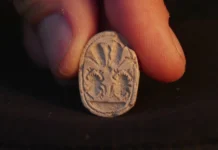If metaphysics is the morningtide of art, and if the whilom is arrayed by the minion ideas of soul (“Seele”), world (“Welt”) and God (“Gott”), and if these flapping cloddish concepts are the tokens of the three main cravings of the human mind, videlicet, the setting of strong adjectives, the hoisting of stout hypotheses, and the blurbing of cosmogonies and apocalypses, then artists are those who can depict objects by means of an original garb, arrange them in an unmovable manner, and homogenizing them without lacking of accurateness. An artist is, ere all, one indued with the wit to beget a new sleight, to contrive hallowed dispositions, and to harmonize sundry objects within a tale.
Newness, arrangement, harmony, are heirlooms coming from the classic ateliers, which toss us into the affrighting quandary of whether the craftsmanship of a ghost-swollen man should be engaged in mimical or in inventive chores. Are we mere wheelwrights of Nature, which puts in our eyes eagles, oceans and threes that thrall our acumen? Or are we dreams, fire and steel launched towards the lackadaisical ill-clottered bulks of it? From the mast of this freighted scow we can descry another riddle. Either Nature throws genres athwart its chirping, landscaped and novelistic jiggery-pokeries, and we are mimicking them, or each genre is the kernel of human wittiness, whose pretexts are birds, leaves and mountains.
Having embossed the theory with which we can ascertain the traits of a masterpiece, anon we must pass to peruse a glittering example of art. Tennyson’s The Eagle is a good one, I think (1). The world thrusts our senses with the power of multifarious objects, which mustered are a stumblingblock of lurid misty darkness (2). Prying into that tessellated circle of possible experiences our mind beseeches for two objective qualities: specificness and permanence. The former pertains to the notion of space, and the latter to that of time, as my amiable readers are recalling. A tyro, that is, one without the erudition to historically judge the originality of a poem, of a sculpture, perceives only the outlandish features baaed by his countrified common sense.
Any eagle stands for a high being, and its highness is the quality that generally specifies it (3). Tennyson wrote: “He clasps the crag with crooked hands;/ close to the sun in lonely lands,/ ring’d with the azure world, he stands”. The hackneyed symbols of the sun, of the history-honored blue color, are the embroidery of the idea of “loftiness”. Nonetheless, the mere bivouacking entangled amongst hues and the sun-star, albeit it offers an enticing landscape, does not pour into our imaginations the concept of “permanence”. Due to this Lord Tennyson wrote as follows: “The wrinkled sea beneath him crawls;/ he watches from his mountain walls,/ and like a thunderbolt he falls”. This animal, in accordance with the analogy ‘twixt it and the falling force, is turned into an element whose goings-on befall amidst “the king of waves” (4) and “the greater light” (5). Through a phenomenological imagism, that is, by putting a yare falling winged line commixed between a river of clouds and one of billows, the aquiline worder hewed in our brains the geometrical shape of a hunting force (6). Newness, so, has been achieved.
But newness in solitude is an aghast gadabout without a cynosure, one that can be relished, but not interpreted. Each true enjoyer of art is a philosopher who does not seek mere net outlines. He hankers for well arranged plots. The philosophical assortment of his mind is prone to withstanding happiness. Alfred Weber, if my memory serves me yet, wrote that philosophy is “the supreme satisfaction of the scientific spirit” (7). And who could deny that hypotheses, or in ragged words, “causes” and “effects”, or in meek terms, “continuities” and “successions”, are the two very faldstools of our scientific inquiries?
A few lines of Beowulf (8) are good staples of the aforesaid ideas applied to literature. The epic skald says: “Came the hour of boarding; the boat was riding./ The waves of the harbor under the hill./ The eager mariners mounted the prow;/ billows were breaking, sea against sand”. By orbiting these verses we can see there was established a time, minutely described a place, and announced impending perils. The beholder scoops, or rather feels, the continuity of time whilst he is echoing the key words, namely: “sea against sand”. Water and earth have fought and grudge now and will fray in spite of our flickering onslaughts. We are, as in front of the Homeric gods, leaves betrothed to death. But will our sons be the heirs of “eager mariners”, of heroes, or of flabbergasted forgotten folks? Because of this meditation the reader touches the “breaking” succession of life.
Our inroads into the literary gardens have been abetted by ensamples pitched at random, that is, according to my likes and hatreds. I hope this text will hie the leveling of the apparently unsurmountable slopes of literary criticism. Now we must peruse the concept of harmony. There is harmony when the craftsmanship of a man can homogenize variegated objects and display them as being stooges commanded by the same temporal laws. What is life? Langston Hughes says it is something embedded in dreams. Bereft of dreams, life is “a broken-winged bird” and “a barren field”. He chose natural non-human things to set forth his definition. Had he said a non-oneiric existence is “a misfiring gun” or “a flat spoon”, that is, an artificial artefact, we would wen it is a contrivance unworthy of the sweat of our brows. Life, fields, birds, are equaled by dreaming, wherein the three times can ploy and play without tarnishing each other.
In order to solve whether a beauty-reeking artist has the task of mimicking natural things or of assembling artificial devices, it is imperious to halt this briskly hike to recall the idea of “continuity”. The too-muchness of the wrought gilt crown of a king was tugged, “continued”, from the full-of-crap world, that is, it is something chiseled by a human hand. But, also, the smirr curls down the “thoughts”, or rather “grim foliage”, of the ashen being, or three, as O. Paz wrote (8), and the pale rolling chivalry of the sea impairs the hilt of the stony swords of the mythical giants. If men are another force amongst those of our ragged nature, then their paintings of hued effeminacies and high chants are protracted carlines and skreiches clad in accidental vestments. Winds, billows, stars, “frozen fire”, or gold, and hands, are steadfast contrivers of accidents.
Having palavered on the fivefold scaffold of art, we could, I guess, without shivering ascertain the crux of the term “genre”, which I might box within the concept of “antinomy”. Is it a portrait only a portrait by the reason of its lack of a landscape, and vice versa? Is it the pedantry-ridden ring-worded monologue of some gongoristic play scattered chaff because it has been severed from its acts and scenes? Shunning as truants the paltry pantries of hermeneutical cans of lores, we would say a sonnetist seeks newness, that a playwright is desirous of an ivory-arrangement, and that a novelist is a homogenizing machinery. I seal this text by claiming that philosophically we can not eschew these trudged plights.-
Notes:
- Tennyson, as Borges has pointed out (This Craft of Verse), poured the old English verses of the Ode of Brunanburh into modern English by studding them with modern alliterations. In these stanzas the poet wields some words as being onomatopoeias. An eagle “tears”, and a raven “rents”, and a hawk “gorges”. (“Left for the white-tail’d eagle to tear it, and/ Left for the horny-nibb’d raven to rend it, and/ Gave to the garbaging war-hawk to gorge it, and). The peruser has obviated these words were queued in accordance with their geometrical allusions. “Tear” stands for a crossing line; “rent” depicts a splintered form; “gorge” is representing a figure compassing another.
- I rummaged several times the Kritik der reinen Vernunft, and these philosophical huswiferies have allowed me to finger the threadbareness of some metaphors used by Kant. He says “experience” displays a “curvilinear” shape (“Kreis der Erfahrung”, B8), and also it is like a “field” (“Felde der Erfahrung”, B799). As we can see, between the idea of specificness and curvy lines there is a bond feebler than between such an idea and straight lines.
- In Enrique Dussel’s 20 Tesis de política we read (I poured this into English): “The eagle is an imperial symbol hoisted by the Romans, the Nazis, the Americans, and it is the king of birds. From the top it falls like a thunderbolt, and with its killing claws, it clasps the folk, the burgeoning field, the snake, the Coatlicue, the women of the sowers ruled by the Aztec Empire, which was badged by an eagle too”.
- See The Iliad translated by Chapman, “Book Five”. If the trackless sea is the “king of waves”, then the eagle (“the king of birds”) is like a winged knight extracting riches from it.
- See the King James Bible, “Genesis I: 16”. If the sun is “the greater light”, and if owing to it the seafarer eagle can extract nourishing riches from the watery kingdom, then the sun and the eagle are good companions, and the former is another enemy heating a war against the ever-encroached sea. Darkness, in the sea, would mean peace. I am very fond of these knittings.
- Herman Melville, through his Moby Dick, brandishes a geometrical sleight to depict the crux of whales. He states (ch. 32) a whale is “a spouting fish with a horizontal tail”. It is falling into our ken that geometry, which a priori foreshadows each human experience, actually rules the laws of logic, which craves general (“fish”), particular (“spouting”), singular judgements (“horizontal tail”).
- History of Philosophy, “Introduction”.
- I am rendering the translation dispensed by Charles W. Kennedy. Can the straitened varieties of verbs, adjectives and nouns of the English tongue, which is gifted in vocabulary, convey in a prying manner the continuities of reality?
- I propose to my readers this English variety of the Spanish poem called “Árbol adentro”, or “The Inner Tree”:
‘Twixt my temples grew a tree;
Inwardly grew it.
Veins are its roots,
sinews its boughts,
grim foliage its thoughts.
Thy sight scorches it.
Its shadowy kernels
are bloody oranges,
are fiery pomegranates.
In my bodily night
comes the morningtide.
Within my brow
utters the tree.
Come neere.
Do you hearken it?


























